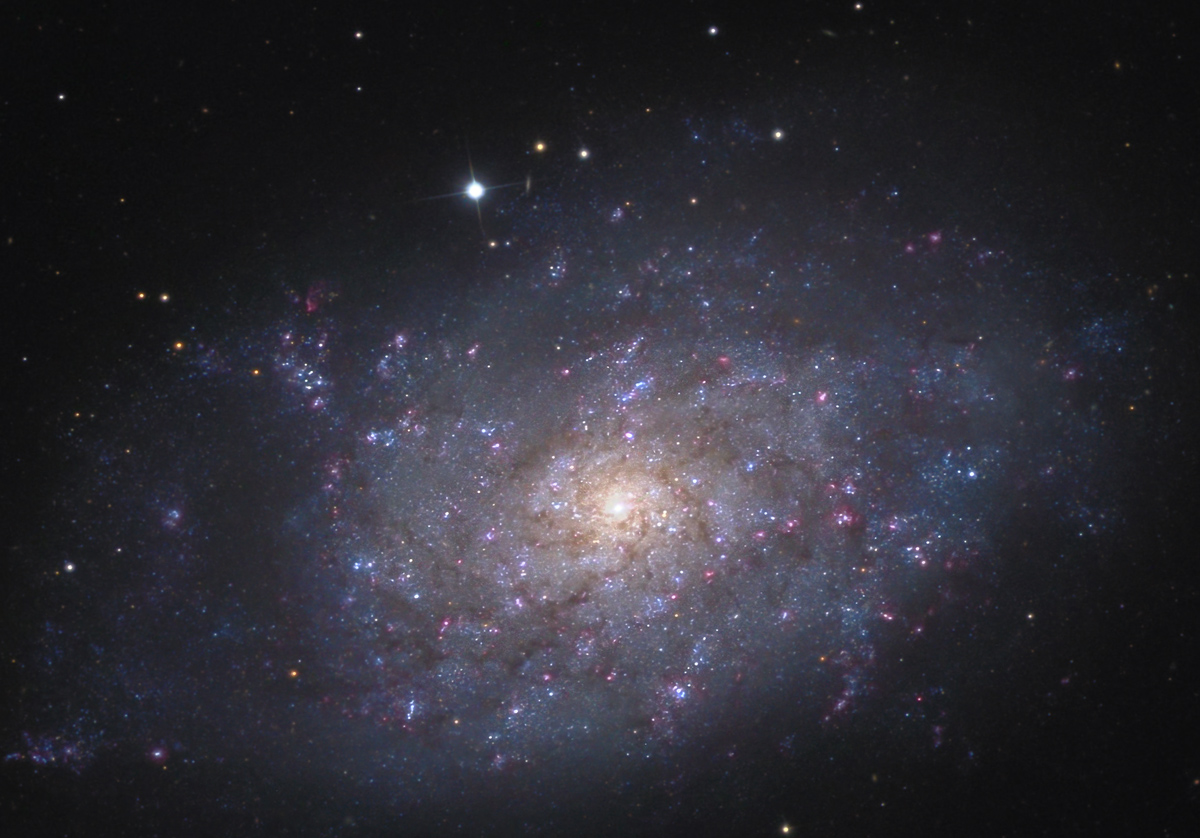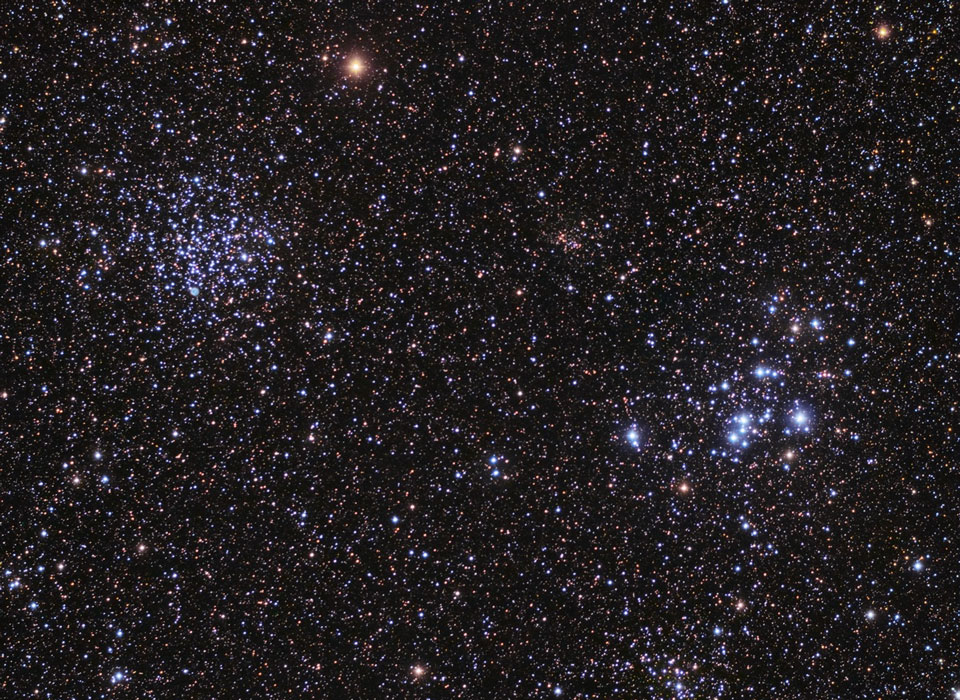MarkBour wrote:
heehaw wrote:Nice that those two bright foreground stars do not happen to lie right on this galaxy! Is there any bright galaxy that IS "spoiled" by a bright star in our own galaxy just happening to lie directly on our line of sight to the distant galaxy?
I like this question ... some thoughts this is inducing:
- Zsolt Frei may be the person to ask ... https://arxiv.org/abs/astro-ph/9606040
- At this point, concerning distant galaxies, I'm assuming we don't yet have any knowledge that would say "this portion of sky is richer in distant-but-observable galaxies than any other", do we? Perhaps one of the sky surveys is giving us an idea, but I assume that would only be able to be determined with deep field images all over the place, right?
I'm just guessing, mind you, but perhaps the
cosmic microwave background (CMB) can give us some clues as to the "galactic density" in various parts of the sky. The picture at left shows a remarkable anisotropy (yin-yang pattern) of the CMB in the sky. But this has nothing to do with the number of galaxies in the sky, but instead reflects "
the motion of the Sun relative to the rest frame of the cosmic microwave background." Nothing strange there. The dipole anisotropy can be removed, which leaves the CMB background looking like the image at right:
https://map.gsfc.nasa.gov/universe/bb_cosmo_fluct.html wrote:
(The image) shows the microwave sky after the dipole anisotropy has been subtracted from the map. This removal eliminates most of the fluctuations in the map: the ones that remain are thirty times smaller. On this map, the hot regions, shown in red, are 0.0002 Kelvin hotter than the cold regions, shown in blue.
The bright red horizontal band is of course the Milky Way. For comparison, you may check out
this superb visible-light portrait of the Milky Way by Nick Risinger.
Clearly the Milky Way has to be removed from the CMB images in order to get all-sky CMB pictures. How do you do that? I don't know.
Nevertheless, if we assume that astronomers know what they are doing when they remove the signal from the Milky Way (but how certain of their facts can they be?), we are left with a map looking like the one at left. As you can see, it isn't perfectly smooth. It is clear that the CMB is not the same temperature everywhere. And since it is generally assumed that tiny variations in the cosmic microwave background eventually led to the formation of galaxies, galaxy clusters and voids, it seems reasonable that the galaxy count down to the appearance of the earliest galaxies in the universe probably isn't the same in absolutely every direction.
Well away from the Milky Way signal on the sky, there is a mysterious cold spot in the CMB.
Wikipedia wrote:
The CMB Cold Spot or WMAP Cold Spot is a region of the sky seen in microwaves that has been found to be unusually large and cold relative to the expected properties of the cosmic microwave background radiation (CMB). The "cold spot" is approximately 70 µK colder than the average CMB temperature (approximately 2.7 K), whereas the root mean square of typical temperature variations is only 18 µK.[1][note 1] At some points, the "cold spot" deviates 140 µK colder than the average CMB temperature.
...
A 2015 study shows the presence of a supervoid that has a radius of 1.8 billion light years and is centered at 3 billion light-years of our galaxy in the direction of the Cold Spot, likely being associated with it.[4] This would make it the largest void detected, and one of the largest structures known.[17][18]
It seems likely that in the region of the CMB cold spot, the galaxy count would be lower than in most other parts of the sky. Similarly, in particularly "hot" spots, the galaxy count would likely be higher.
Simulation of the structure of the universe. Millenium Simulation, MPA Garching,
V. Springel, S. White et al.
The universe isn't smooth. Instead it is made up of filaments of galaxies and galaxy clusters, and voids between them. If you look in the direction of a bright filament, the galaxy count should definitely be higher than in the direction of a dark void. However, the distribution of filaments and voids should be
fairly the same all over the sky. It's like looking at a
checked shirt: It does not look the same in every spot, but the overall pattern is the same.
MarkBour wrote:So, assuming there are distant galaxies most everywhere you look, then behind any globular or open cluster, there ought to be plenty of galaxies that are going to be difficult to image, and in fact I would wager there are galaxies that are completely eclipsed by stars. That would be a matter for statistics; except for stars that would actually move from our parallax, we're not going to know about such occurrences any time soon, barring some super-clever astronomer finding a technique to detect such a thing.
I'm just saying,
You can't be Sirius! Globular cluster hidden in glare of brightest star.

Indeed, there ought to be lots and lots of galaxies that haven't been detected because they are hidden behind behind all kinds of stuff in the Milky Way. I guess that all we can do is to make educated guesses as to how many galaxies there are in the parts of the sky that are located behind the Milky Way. We should assume that the region hidden behind the Milky Way is no different from other parts of the sky, but of course we can't be absolutely, totally certain. Just almost totally certain.
By the way, did you know that the earliest galaxy hunters (in the early 20th century and possibly the late 19th century) used to call the region of the Milky Way "the zone of avoidance"? Well, because galaxies avoided that zone! Fancy that!
Ann
 NGC 3621: Far Beyond the Local Group
NGC 3621: Far Beyond the Local Group






